Let The Games Begin
The benchmarks the teams had to compete in were slightly different from the heats, comprising Super PI 32M and 3DMark Vantage. Points were awarded based on the results of each bench, with first place in Super PI worth 12 points, 10 for second, 8 for third, 6 for fourth and 4 for fifth.In 3DMark, points were awarded for a graphics score, and for an overall score – 6 for finishing first in the graphics test, down to 2 points for fifth. A first place in 3DMark’s overall score would net the team 10 points, with 8 for second, 6 for third, 4 for fourth and 2 for fifth. The winners stood to take home $5,000 in cash plus sponsor products.
After a series of speeches from the various companies involved – and the enthusiastic smashing of an innocent ice sculpture – it was on to the overclocking, with the competition taking around five hours to complete. With much at stake and the speeches taking a while to wind up, the atmosphere was businesslike when the teams finally got down to the overclocking.
Despite Taipei 101 being a new and rather expensive building, even its air conditioning couldn’t cope with the heat the overclocked systems were kicking out, and so the teams happily resorted to cold beers to keep themselves from overheating.
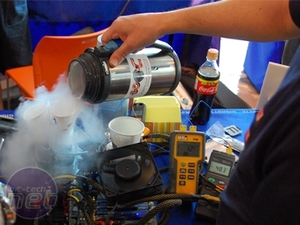
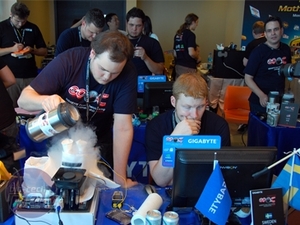
Left: LN2 action; Right: the Swedish team
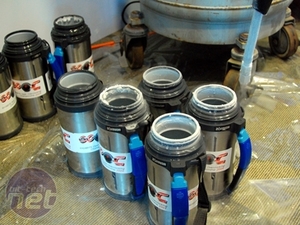
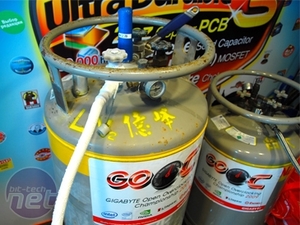
Gigabyte provided lots and lots and lots of LN2
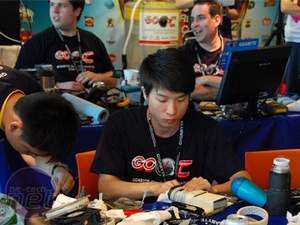
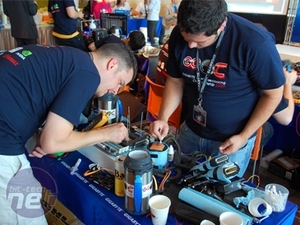
Left: the Chinese team working on their overclock; Right: The Australian team tinker with the rig
The US team, sno.lcn and Miahallen had hardware troubles from the start, with their overclocking efforts plagued by DOA motherboards and underperforming CPUs. After finally finding a decent combination of hardware, the team then suffered from condensation problems when the Super PI competition kicked off. As a result, the guys posted the slowest completion time.
It was the European winners, Belgium’s Pt1t & Massman who triumphed in this, posting the quickest time of 6:40.187, pushing their CPU to 5.63GHz (181MHz FSB, x31 multiplier, and a QPI of 3.271GHz). Elmor and Sf3d were close behind with their chip clocked to 5.5GHz (177.9MHz FSB, x31 multiplier, QPI 3.202GHz).
Super PI 32M
- 1 - Pt1t & Massman - 06:40.187
- 2 - Elmor & Sf3d - 06:44.125
- 3 - Fugger & Vapor - 06:48.688
- 4 - x800pro & Lok - 06:52.984
- 5 - Dinos22 & Deanzo - 06:53.672
- 6 - Miahallen & sno.lcn - 07:14.078
Next it was on to 3DMark Vantage, a tougher test as the teams had to balance CPU overclocking with maximising the potential of their two GeForce GTX 260 graphics cards. The US team suffered again, but couldn’t get Windows to see both cards, and so sadly didn’t get to post a score.
3DMark Vantage
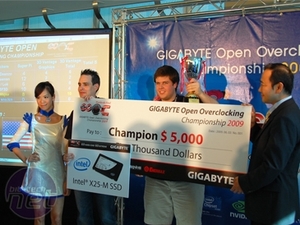
- 1 - Fugger & Vapor – GFX: 27,642 / Overall: 28,093
- 2 - x800pro & Lok – GFX: 26,179 / Overall: 27,171
- 3 - Elmor & Sf3d – GFX: 25,432 / Overall: 26,799
- 4 - Pt1t & Massman – GFX: 24,752 / Overall: 26,065
- 5 - Dinos22 & Deanzo – GFX: 26,088 / Overall: 26,977
- 6 – Miahallen & sno.lcn – DNF
Fugger and Vapor pulled their CPU back from the 5.4GHz they’d used for the Super PI test to 4.8GHz (146MHz FSB, x33 multiplier, 2.627GHz QPI), but had their cards’ GPUs clocked at just under 900MHz, up from 576MHz, with the memory at 1.3GHz, up from 999MHz and the shaders at close to 1.9GHz, compared to their stock clock of 1.242GHz. Unsurprisingly, this is a 3DMark Vantage world record for GTX 260s in SLI with PhysX disabled.
It was also enough, under the points scoring system to give Fugger and Vapor an overall score of 24 points, five more than the Chinese team and so enough to crown them champions. As befits this kind of event, they were then presented with an over-sized cheque, and a pile of hardware by a parade of booth babes. We did suggest they sprayed liquid nitrogen as Jensen Button does champagne, but this was abandoned for safety reasons.
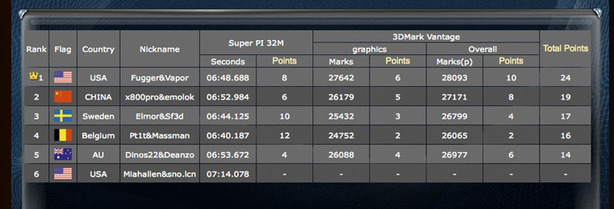
The final scores

MSI MPG Velox 100R Chassis Review
October 14 2021 | 15:04









Want to comment? Please log in.